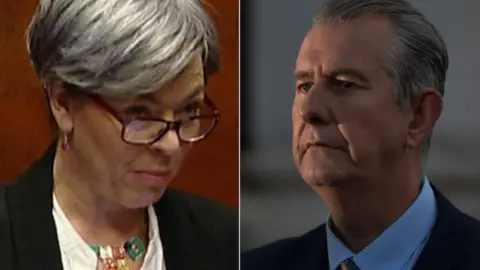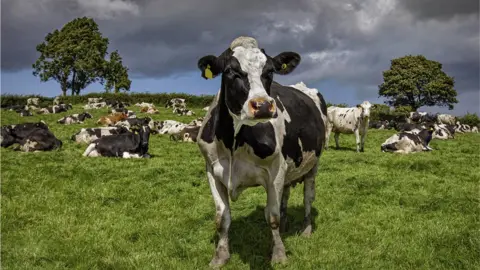Climate change: Where are we now with Stormont's new legislation?
 BBC/Getty Images/Nur Photo
BBC/Getty Images/Nur PhotoNorthern Ireland moved a step closer to putting climate legislation in place on Tuesday.
But the bill has been modified, not just from what it originally set out to achieve, but from what was passed at the consideration stage.
So where do things stand now?
There are two climate changes bills, so which one is this?
This is Climate Change (No2) Bill - the Executive bill brought by the Agriculture and Environment Minister Edwin Poots.
His bill was second off the blocks, after Climate Change (No1) Bill was brought by the Green Party leader Clare Bailey.
Ms Bailey's bill initially progressed more quickly, but because Minister Poots' bill is Executive business, it has been prioritised as the assembly seeks to clear the decks in the run-up to dissolving for the election.
It has just finished its further consideration stage, and will now be scrutinised by the Speaker before being moved to final stage by the minister next Tuesday, 8 March.
After that, it goes for Royal Assent and becomes legislation.
What's the difference between the two bills?
The devil is in the detail, but the main difference was targets.
Bill (No1) set an ambition of reaching net zero by 2045 while Bill (No2) went for an 82% reduction by 2050.
Mr Poots argued that his target was in line with the recommendation from the UK's Committee on Climate Change (CCC) which advises the government.
It said a reduction in emissions, rather than a net zero target, was more realistic for Northern Ireland, because of its reliance on agriculture - it is a big part of the local economy.
But backers of Bill (No1) said Bill (No2) lacked ambition in not setting a net zero target.
There were other differences too, around Just Transition provisions - how sectors would be supported to make the required adjustments without being unduly penalised - and oversight, with Bill (No1) calling for a climate commissioner.
Many of those changes have now been incorporated in Bill (No2) after 70 amendments were voted on during the consideration and further consideration stages.
So the bills have become more similar than when they started out.
The first big change for No1 came at consideration stage, when the assembly rejected the 82% reduction and voted instead for a net zero target by 2050.
Then at further consideration, the minister got his own amendment passed, limiting the required reduction in one specific Greenhouse Gas (GHG) - methane - to no more than 46%.
 Getty Images/Alan Hopps
Getty Images/Alan HoppsWhat is so special about methane?
Methane is mostly produced by agriculture, through the excretions of ruminants - farm animals like cows, sheep and goats.
It does not hang around long - up to 12 years or so - but it is extremely potent in that time, with a warming effect more than 80 times greater than carbon.
There is a lot of work being done on trying to reduce the amount of methane farm animals produce.
That is through things like:
- supplementing cattle feed with seaweed, as was approved by the EU this week
- using "burp catchers" on cows' noses (basically powder puffs to trap the methane as it is being belched out)
- mechanical solutions like Lower Emission Slurry Spreading Equipment (LESSE), to reduce the amount produced when slurry is mixed and spread on the fields.
But developments like that cost money and the more scientific ones will take time to reach the fields.
And farmers say they should be given more credit for the carbon trees and hedgerows in their fields lock away.
What does this new target mean for methane?
Basically, it means methane has been separated out from other GHGs.
Which, as several assembly members said in the chamber, is something the CCC says should not happen - it says net zero is based on the aggregated total of all GHGs.
 Getty Images/Andrew Linscott
Getty Images/Andrew LinscottSo, are we going for net zero or what?
Well, the target in the bill is net zero by 2050.
But farmers are reasonably content that the main gas their industry produces only needs to be reduced by 46%, as its contribution to that target.
One farmer told me it felt like they were "still on a hook", but a hook they thought they could work with.
But if one GHG is being treated differently, that could mean greater cuts will be needed in other gases to meet the overall net zero requirement. Nobody is quite sure how this will work out.
What is going to happen to the other bill now?
That is another $64,000 question. Climate Change (No1) Bill is scheduled for its Consideration Stage next Tuesday 8 March.
Now if that date sounds familiar, that is because way back at the start of this article, you will have read that Climate Change (No2) is set for its Final Stage that same day.
This has been an unprecedented situation all along - to have two bills with similar broad aims on the track to becoming legislation.
So, for example, if the minister moves Bill (No2) on Tuesday morning, then does Bill (No1) go ahead anyway?
And what happens if No1 gets through without requiring a further consideration stage and also crosses the finish line before the assembly dissolves for the election?
Some may ask, is it really an efficient use of the assembly's dwindling time in this mandate to debate amendments on a bill which is similar to another one already ahead of it and in the queue for Royal assent?
But Northern Ireland has been so far behind the rest of the UK nations and the Republic of Ireland in getting climate change legislation in place, that to get anything on the books, even at the last minute, will be seen as a triumph.
